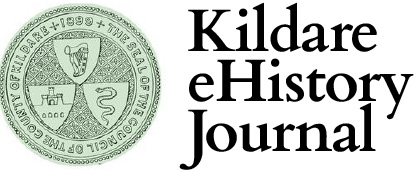The Cassidys of Monasterevin

The new Diageo brewery in Littleconnell, Newbridge is due to start producing ales and lagers (and possibly stout too) for the market in 2026. It’s important to remind ourselves, though, that this is not Kildare’s first foray into large-scale brewing or distilling.
Situated along the Dublin Road in Monasterevin, is the abandoned ‘Cassidy Complex’. In the late eighteenth century, John Cassidy started distilling here. The site would later host a brewing facility too.
Not far from Dublin and with the River Barrow and Grand Canal nearby, the advantages of Monasterevin for brewing were obvious. The facility in its prime would have been a very impressive sight, commanding its own water supply and mill race. According to a Conservation Management Plan carried out on behalf of Kildare County Council in 2024, the facility was producing 250,000 gallons of whiskey annually by 1887. The Kildare Observer of July 30, 1932, reminds us that: ‘At one time, Monasterevin was a bee-hive of industry and large numbers of men were employed by Cassidy’s Brewery and distillery and malt houses’
The prosperity that this enterprise brought to the town is obvious when you take a walk down Main Street. Situated here are the dwellings of the successful merchant class who thrived on the industrialisation of Monasterevin and the introduction of the canal in the late eighteenth century. These quaint three-story terraced houses cast their benevolent gaze over the idling river below. Monasterevin deserves its sobriquet ‘The Venice of Ireland’.
The poet Gerard Manley Hopkins was no stranger to Monasterevin. Norman White mentions in his book Hopkins In Ireland, that: ‘…when Christmas 1886 approached it was decided that he [Hopkins] should spend it with the Cassidys of Monasterevin…’ He travelled down from Dublin by train, and when he alighted: ‘A Cassidy carriage was waiting for Hopkins, with Mr. James Cassidy to meet him’ (Hopkins In Ireland)
Picture the carriage moving briskly towards the town, the milky waters of the Grand Canal to Hopkins’ right. As he made his way to the Cassidy residence, one can only imagine the sights, the sounds and the heady smell of brewing and distilling that embraced his olfactory senses.
What a great legacy indeed, one worth protecting. As Hopkins wrote in his poem Binsey Poplars: ‘When we hew or delve/ After-comers cannot guess the beauty been’.
Sources:
Cassidy’s Complex CMP Report, 2024, by Howley, Hayes, Cooney Architecture
The Kildare Observer, July 30, 1932
Hopkins In Ireland, by Norman White
The images used are from postcards which are in our collection in Local Studies. Don’t forget that Local Studies also provide free access to the Irish Newspaper Archives and the British Newspaper Archives.
By Kevin Dowling, Kildare County Archives and Local Studies.
